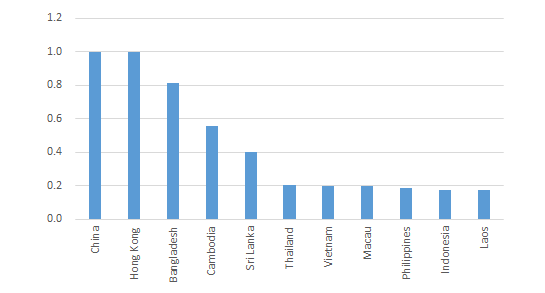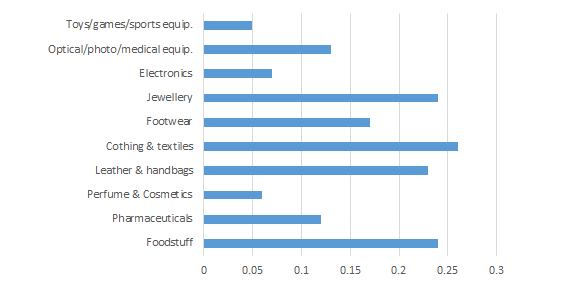Counterfeits
/There is a new report out from the OECD about counterfeiting in the world, and there were some interesting statistics about Vietnam in there that I wanted to highlight.
First, the main point of the report is that counterfeiting is big business. About 3.3% of all world trade is of counterfeit goods. The major categories are: pharmaceuticals, food stuff, perfume & cosmetics, leather goods, clothing & textiles, footwear, jewellery, electronics, optical/photo/medical equipment, and toys/games. About 22% of the value of seizures is in footwear, the largest category. Clothing is second at 16%. The United States is the country most affected by counterfeiting, with brands or patents from their making up about 24% of all fake products seized.
IN 2016, VIETNAM WAS NOT MUCH WORSE THAN ITS NEIGHBORS. NOTE: THE NUMBERS REFER TO THE 2016 GTRIC INDEX WHICH IS A STATISTICAL MEASURE OF COUNTERFEITING COMPARED TO IMPORT VOLUMES FROM THE RESPECTIVE COUNTRY. A HIGHER SCORE CORRESPONDS TO A GREATER LIKELIHOOD THAT THE ECONOMY IN QUESTION IS A SOURCE OF COUNTERFEIT GOODS. SOURCE: OECD, VIETECON.COM
IN 2016, VIETNAM WAS NOT MUCH WORSE THAN ITS NEIGHBORS. NOTE: THE NUMBERS REFER TO THE 2016 GTRIC INDEX WHICH IS A STATISTICAL MEASURE OF COUNTERFEITING COMPARED TO IMPORT VOLUMES FROM THE RESPECTIVE COUNTRY. A HIGHER SCORE CORRESPONDS TO A GREATER LIKELIHOOD THAT THE ECONOMY IN QUESTION IS A SOURCE OF COUNTERFEIT GOODS. SOURCE: OECD, VIETECON.COM
Even emerging economies, like China and Brazil, suffer from counterfeiting. It will be interesting to see how China starts to deal with IP issues when it is the victim. It will likely follow the trajectory of every developing country in the modern era, including the US, by promoting intellectual property rights when it matters to itself. The case of Huawei and 5G is a great example. The country is the largest owner of 5G patents, and it will likely get a large percentage of license fees for these patents. Of course they are going to want to defend them. My question is: will they defend them in Western countries where the legal regime is predisposed to support property rights while ignoring other IP violations at home that would affect its own manufacturers?
But to Vietnam. It looks like poor Vietnam is the #8 source of counterfeit goods in the world (in terms of the value seized), or at least it was in 2014. It fell below the top 12 in 2015 and 2016, according to the OECD (see Figure 3.1 here). But it is small potatoes compared to China and Hong Kong, which combined make up about 80% of all seized goods. Malaysia, Singapore and Thailand are other Asian economies that consistently rank higher than Vietnam. Generally, Vietnam isn’t that bad.
However, my caution is that trade in counterfeit goods correlates to trade in general, so more trade means more counterfeits. Vietnam’s exports have been rising in double digits: they more than doubled from 2011 (USD101bn) to 2017 (USD220bn).
CLOTHING, JEWELLERY AND FOODSTUFF ARE MOST SUSPECT FROM VIETNAM. NOTE: THIS IS THE SAME GTRIC INDEX MENTIONED ABOVE BUT FOR 2011-2013. SOURCE; OECD, VIETECON.COM
Diving a little deeper, there is an older OECD report that looks at what categories are most counterfeited by country. For Vietnam, it is clothing & textiles, followed by a tie between jewellery and foodstuff, with leather & handbags just below. These all have a GTRIC-e Index of between 0.23 to 0.26 (GTRIC-e is a statistical index that the OECD came up with. It’s complicated, but for our purposes, the higher the number the greater the likelihood that the economy in question is a source of these types of countefeit goods).
Interestingly, these goods usually transit through Hong Kong and Singapore onward to their other destinations. The UAE is another big transit spot, as is Saudi Arabia (which seems strange to me, given how expensive logistics are in the Kingdom).
Back to the original report, the main drivers of counterfeiting are weak governance (corruption), free trade zones (FTZs, example: UAE with the Jebal Ali port), low labor costs combined with weak labor regulations, fast logistics combined with a weak ability to track goods, and finally trade facilitation policies. Weak governance is key, because it means that it is easy to take advantage of all of the rest. If corruption is endemic, then having an FTZ makes it worse. Same with weak labor regs or trade facilitation policies that don’t put a stop to exports of counterfeits.
Vietnam is actually doing better than other countries. It is ranked #41 in terms of propensity to export counterfeits in the more recent report, but is the 21st largest export economy in the world. It may be helped by the fact that Samsung made up almost a quarter of Vietnam’s exports (2017). Samsung wants to protect its IP. Of course, with more exports from Vietnam including from Chinese companies exporting from the country, we will likely see these counterfeit figures from Vietnam increase, unless there is a countervailing crackdown from the government. Most of the recent corruption cases in Vietnam have been about land, so I haven’t seen much so far.
Big picture, though, I want to say that counterfeiting is just the way that developing countries develop. They copy and steal and manufacture copied/stolen IP. The US did it. Japan did it. China is doing it. But once a country actually owns sizeable amounts of IP, they start to care much more. You don’t see South Korea on these charts, because they have started to create their own IP. And that’s normal. Of course, it sucks for companies that own the IP, and potentially consumers that are hurt by shoddy goods. I am all for people defending their IP - don’t steal my blog! [Ed - actually, given that readership levels are low, I think it would be fine if they credited you somewhere]. But it’s never going to get to 100%, and that’s probably alright. Think of it is as a tax paid by IP owners to poor people in developed countries, a crude correction to income inequality.



